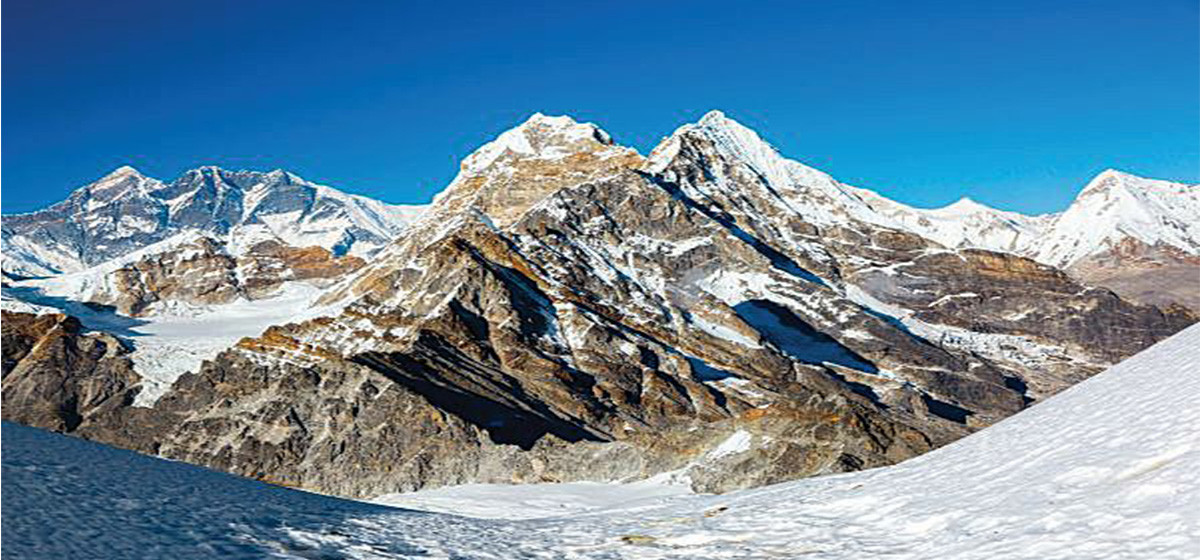KATHMANDU, July 19: Deepening the intrigue surrounding Mount Everest, the depth of snow on its summit has long captured the curiosity of researchers and mountaineers. Past studies have yielded inconsistent and uncertain results regarding this remote and towering peak. However, a recent scientific breakthrough offers newfound clarity. Chinese scientists who recently conducted measurements on the northern slopes of Everest, have determined that the world’s tallest mountain’s peak boasts an impressive 9.5 meters of snow. This remarkable finding challenges previous estimates, which ranged from 0.9 to 3.5 meters, over the past five decades.
In 1975, measurements made by a Chinese climbing team using wooden pointed sticks (wooden stakes) showed that the snow depth was 0.92 meters. Similarly, in 1992, a joint team of Italy and China measured the depth of snow on Everest peak by inserting a steel stake into the snow and determined that the depth of the snow was 2.52 meters. But due to the density of the snow, the length of the stick and bad weather, it was difficult to measure the depth accurately.
In 2005, the depth was found to be 3.5 meters, as measured by the Chinese mountaineering and surveying team using the radio echo-sounding (RES) technique. According to the researchers, although the Nepali and Chinese teams measured the snow depth with the help of radar equipment in 2019 and 2020, the results were not made public.
In April and May, 2022, this measurement based on the ground-penetrating radar (GPR) technique showed that the snow on the summit of Mount Everest is much deeper than previously thought.
Snow cover in Hindu Kush region drops sharply

The Cryosphere, an online publication of the European Geo-science Union, recently published the study results in the scientific journal ‘Nature’.
China and Nepal jointly declared the height of Mount Everest to be 8848.86 meters in 2020, but it is difficult to determine the exact height of the rock due to the uncertainty of the exact depth of the snow on the peak.
At this highest elevation on Earth, the depth of snow varies between seasons and years. Experts believe that the actual height of Mount Everest is disputed due to differences in the snow layer, refraction of light and gravity deviation. Recent studies have shown that even the height of Mount Everest may change. In this study, scientists from the Institute of Tibetan Plateau Research (ITP) under the Chinese Academy of Sciences (CAS) measured at 26 different points to find out the difference between the rock surface and the snow depth at an altitude of more than 7,000 meters. These measurements show that the depth of snow is 9.5 meters; however the scientists guess that the measurement can have a margin error of about 1.5 meters.
“Our measurements surprisingly showed that the depth of the snow is 9.5 meters. It appears to be much deeper than previously thought," Yang Wei, a professor at the Institute of Tibetan Plateau Research, said in a video posted on Cryosphere's website. He said problems with previous studies were due to snow density, distance between measurement points and highest elevations. The reliability of the study is confirmed by the consistency observed during depth detection at different measurement points with the help of a radar. It has also revealed new facts about the level of Mount Everest," the scientist said in the study report. Scientists have been interested in the effects of human-caused climate change, especially on the snow and glaciers in the highest areas of the earth.
Researchers have said that based on the results of measurements in different seasons, it will be clear how climate change is affecting the Himalayas. They say that drilling down into the snow layer and using GPR measurement techniques can further assess changes in the layers of snow. There is a lack of evidence to say if the ice layer got thicker or thinner in the last decade. "Repeated radar measurements at the summit of Mount Everest will facilitate the assessment of the impact of climate change on this region," the researchers said.
What do Nepalis scientists say?
A Nepali scientist, who was not involved in the study, has provided a response stating that the scientific significance of the study's findings is high, and there is widespread interest in the study and results of the research.
Dr Shobhakar Dhakal, a professor at the Asian Institute of Technology in Thailand specializing in energy, environment, and climate change, says that there is still insufficient scientific understanding regarding the dynamic changes taking place in the snow of Mount Everest, and it is crucial to confirm the accurate height of the rock of Mount Everest.
"This result will help to understand the effect of climate change on the snow of Mount Everest. More measurements and comparative studies are needed in the future to understand these types of effects,” added Dhakal.


































